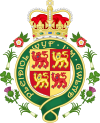
| This article is part of a series within the Politics of the United Kingdom on the |
| Politics of Wales |
|---|
 |
Welsh devolution is the transfer of legislative power for self-governance to Wales by the Government of the United Kingdom.[1]
Wales was conquered by England during the 13th century, with the Laws in Wales Acts 1535 and 1542 applying English law to Wales and incorporating it into England, and later Great Britain and the United Kingdom.
A rise in Welsh nationalism and political movements advocating for Welsh autonomy became more prominent in the late nineteenth century. The devolution of some administrative responsibilities began in the early twentieth century, as well as the passing of laws specific to Wales. Since World War II, various movements and proposals have advocated different models of Welsh devolution. In 1979, a referendum on devolution was rejected by 79% of voters amid regional divisions and cultural concerns, but by 1997 support for devolution had increased and was narrowly supported in a referendum. Laws were subsequently passed to establish the National Assembly for Wales and grant it secondary legislative powers over areas such as agriculture, education and housing. The third referendum in 2011 saw voters support full primary law-making powers for the National Assembly over specified areas of governance. After the Senedd and Elections (Wales) Act 2020, the National Assembly was renamed "Senedd Cymru" (in Welsh) and the "Welsh Parliament" (in English) (also collectively referred to as the "Senedd"), which was seen as a better reflection of the body's expanded legislative powers.
The Welsh Labour Party advocates for further Welsh devolution and "far-reaching federalism" with powers equal to those of Scotland and Northern Ireland, whilst the Welsh nationalist party, Plaid Cymru has described devolution as a stepping stone towards full Welsh independence.
| History of Wales |
|---|
 |
- ^ "Devolution: A beginner's guide". 2010-04-29. Retrieved 2022-02-01.
